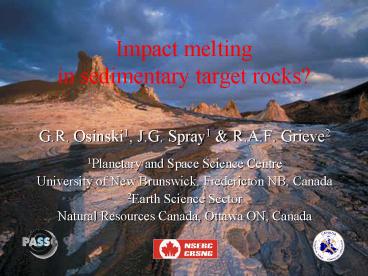Impact melting in sedimentary target rocks? - PowerPoint PPT Presentation
Title:
Impact melting in sedimentary target rocks?
Description:
102 LESS than for crystalline target rocks in comparably sized impact craters ... U. Jurassic Malm limestones 350 m pre-impact depth. Modeling ... – PowerPoint PPT presentation
Number of Views:41
Avg rating:3.0/5.0
Title: Impact melting in sedimentary target rocks?
1
Impact meltingin sedimentary target rocks?
- G.R. Osinski1, J.G. Spray1 R.A.F. Grieve2
- 1Planetary and Space Science Centre
- University of New Brunswick, Fredericton NB,
Canada - 2Earth Science Sector
- Natural Resources Canada, Ottawa ON, Canada
2
Impact melting in sedimentary rocks?
- Kieffer Simonds (1980)
- Volume of impact melt documented
- 102 LESS than for crystalline target rocks in
comparably sized impact craters - Volume of target material shocked to pressures
sufficient for melting - NOT significantly different in sedimentary or
crystalline rocks - ANOMALY attributed to unusually wide dispersion
of shock-melted sedimentary rocks by expansion of
sediment-derived vapour
3
Haughton impact structure
Ries impact structure
- Strat colums
Data from Thorsteinsson Mayr (1987)
Data from Schmidt-Kaler (1978)
4
Crater fill impactites at Haughton
5
(No Transcript)
6
Nature of the groundmass
- Unshocked microcrystalline CALCITE, generally
occurring as irregular blebs and globules (20-90
vol) - Silicate-rich GLASS (5-40 vol)
- Si-Mg-Al-rich glasses yielding relatively high
(85 wt) totals - Si-Mg-Al-CO2-rich glasses - low totals (60-65 wt
) - Comprise the bulk (gt95 vol) of the
matrix-forming glasses - Si-rich glass particles - high totals (90-95
wt) - Rare, sometimes angular (early-formed melt?)
7
(No Transcript)
8
Evidence for shock melting of carbonates
- Carbonate-silicate liquid immiscible textures
- Anomalous calcite compositions
- Calcite spheres in the matrix
- Carbonate overgrowths on dolomite clasts
- Assimilation of dolomite clasts
- Infiltration of calcite and silicate-rich matrix
phases into clasts - Ca-Mg silicates
9
(No Transcript)
10
(No Transcript)
11
Anomalous calcite composition
Analysis 1 2 3 4 5
SiO2 1.0 3.2 2.1 1.8 -
Al2O3 0.2 0.5 0.6 7.9 -
FeO - - - - 0.2
MgO 0.8 3.3 2.7 - 0.7
CaO 55.9 47.5 48.0 49.1 54.9
SO3 - 0.9 0.7 - -
Cl 0.3 - 0.2 - -
Total 58.2 55.4 54.3 58.8 55.8
Ti, Mn, Na K were analyzed for but were below
detection for all analyses
12
(No Transcript)
13
Ries impact structure, Germany
14
(No Transcript)
15
(No Transcript)
16
(No Transcript)
17
SiO2-rich glasses
- Ubiquitous in fallout suevites (Osinski, 2003)
- Occur as individual particles/clasts in the
groundmass or as inclusions in other glass
particles - Composition
- 85-100 wt SiO2
- FeO, MgO, CaO, Na2O lt1-2 wt
- Al2O3, K2O 1-6 wt
- Protolith
- L. Jurassic and Triassic sandstones
- gt350lt770 m pre-impact depth
18
(No Transcript)
19
Al-Ca-H2O-rich glasses
- Recognized in 4 samples (Osinski, 2003)
- Composition
- Low SiO2 50-53 wt
- High Al2O3 (17-21 wt) and CaO (5-7 wt)
- Oxide totals 83-88 gt substantial volatile
contents - Protolith
- Clay-rich sedimentary rocks (shales, claystones
etc.) from lowermost part of sed. sequence - High CaO content may suggest a component of marls
in the melt zone
20
(No Transcript)
21
(No Transcript)
22
Evidence for shock melting of carbonates
- Calcite occurs as globules in silicate-rich
glasses and in the groundmass - Unequivocal evidence for liquid immiscibility
(Graup, 1999 Osinski, 2003) - Protolith
- U. Jurassic Malm limestones
- lt350 m pre-impact depth
23
Modeling
- No modeling carried out at Haughton to date
- Ries impact structure (Stoffler et al., 2002)
- Modeling suggests shock melting of sandstones
confirmed by our analytical SEM studies (Osinski,
2003) - Modeling invokes shock degassing of carbonates
NOT supported by optical and analytical SEM
studies (Graup, 1999 Osinski, 2003)
24
Conclusions
- Carbonate-rich crater-fill deposits at Haughton
are carbonate-rich impact melt breccias - Shocked-melted sedimentary rocks preserved in
proximal ejecta from the Ries impact structure - No evidence for decomposition and degassing of
carbonates from Haughton or Ries - Shock melting of sedimentary rocks occurred
during the Haughton and Ries (and Chicxulub)
impact events - Agreement with theoretical studies which suggest
that impacts into sedimentary targets should
produce as much melt as impacts into crystalline
targets
25
(No Transcript)































